| Truncated tetraapeirogonal tiling | |
|---|---|
 Poincaré disk model of the hyperbolic plane | |
| Type | Hyperbolic uniform tiling |
| Vertex configuration | 4.8.∞ |
| Schläfli symbol | tr{∞,4} or |
| Wythoff symbol | 2 ∞ 4 | |
| Coxeter diagram | |
| Symmetry group | , (*∞42) |
| Dual | Order 4-infinite kisrhombille |
| Properties | Vertex-transitive |
In geometry, the truncated tetraapeirogonal tiling is a semiregular tiling of the hyperbolic plane. There are one square, one octagon, and one apeirogon on each vertex. It has Schläfli symbol of tr{∞,4}.
Related polyhedra and tilings
| Paracompact uniform tilings in family | |||||||
|---|---|---|---|---|---|---|---|

|

|

|

|

|

|

| |
| {∞,4} | t{∞,4} | r{∞,4} | 2t{∞,4}=t{4,∞} | 2r{∞,4}={4,∞} | rr{∞,4} | tr{∞,4} | |
| Dual figures | |||||||

|

|

|

|

|

|

| |
| V∞ | V4.∞.∞ | V(4.∞) | V8.8.∞ | V4 | V4.∞ | V4.8.∞ | |
| Alternations | |||||||
(*44∞) |
(∞*2) |
(*2∞2∞) |
(4*∞) |
(*∞∞2) |
(2*2∞) |
(∞42) | |
= |
= |
||||||
| h{∞,4} | s{∞,4} | hr{∞,4} | s{4,∞} | h{4,∞} | hrr{∞,4} | s{∞,4} | |

|

|

|

| ||||
| Alternation duals | |||||||

|

|
||||||
| V(∞.4) | V3.(3.∞) | V(4.∞.4) | V3.∞.(3.4) | V∞ | V∞.4 | V3.3.4.3.∞ | |
| *n42 symmetry mutation of omnitruncated tilings: 4.8.2n | ||||||||
|---|---|---|---|---|---|---|---|---|
| Symmetry *n42 |
Spherical | Euclidean | Compact hyperbolic | Paracomp. | ||||
| *242 |
*342 |
*442 |
*542 |
*642 |
*742 |
*842 ... |
*∞42 | |
| Omnitruncated figure |
 4.8.4 |
 4.8.6 |
 4.8.8 |
 4.8.10 |
 4.8.12 |
 4.8.14 |
 4.8.16 |
 4.8.∞ |
| Omnitruncated duals |
 V4.8.4 |
 V4.8.6 |
 V4.8.8 |
 V4.8.10 |
 V4.8.12 |
 V4.8.14 |
 V4.8.16 |
 V4.8.∞ |
| *nn2 symmetry mutations of omnitruncated tilings: 4.2n.2n | ||||||||||||||
|---|---|---|---|---|---|---|---|---|---|---|---|---|---|---|
| Symmetry *nn2 |
Spherical | Euclidean | Compact hyperbolic | Paracomp. | ||||||||||
| *222 |
*332 |
*442 |
*552 |
*662 |
*772 |
*882 ... |
*∞∞2 | |||||||
| Figure | 
|

|

|

|

|

|

|

| ||||||
| Config. | 4.4.4 | 4.6.6 | 4.8.8 | 4.10.10 | 4.12.12 | 4.14.14 | 4.16.16 | 4.∞.∞ | ||||||
| Dual | 
|

|

|

|

|

|

|

| ||||||
| Config. | V4.4.4 | V4.6.6 | V4.8.8 | V4.10.10 | V4.12.12 | V4.14.14 | V4.16.16 | V4.∞.∞ | ||||||
Symmetry
The dual of this tiling represents the fundamental domains of , (*∞42) symmetry. There are 15 small index subgroups constructed from by mirror removal and alternation. Mirrors can be removed if its branch orders are all even, and cuts neighboring branch orders in half. Removing two mirrors leaves a half-order gyration point where the removed mirrors met. In these images fundamental domains are alternately colored black and white, and mirrors exist on the boundaries between colors. The subgroup index-8 group, (∞2∞2) is the commutator subgroup of .
A larger subgroup is constructed as , index 8, as , (4*∞) with gyration points removed, becomes (*∞∞∞∞) or (*∞), and another , index ∞ as , (∞*2) with gyration points removed as (*2). And their direct subgroups , , subgroup indices 16 and ∞ respectively, can be given in orbifold notation as (∞∞∞∞) and (2).
| Small index subgroups of , (*∞42) | |||||||||||
|---|---|---|---|---|---|---|---|---|---|---|---|
| Index | 1 | 2 | 4 | ||||||||
| Diagram | 
|

|

|

|
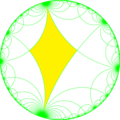
|

| |||||
| Coxeter | |||||||||||
| Orbifold | *∞42 | *∞44 | *∞∞2 | *∞222 | *∞2∞2 | ∞2× | |||||
| Semidirect subgroups | |||||||||||
| Diagram | 
|
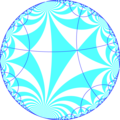
|

|

|

| ||||||
| Coxeter | = |
= | |||||||||
| Orbifold | 4*∞ | ∞*2 | 2*∞2 | ∞*22 | 2*∞∞ | ||||||
| Direct subgroups | |||||||||||
| Index | 2 | 4 | 8 | ||||||||
| Diagram | 
|
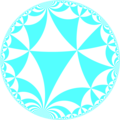
|

|
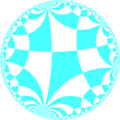
|

| ||||||
| Coxeter | = | ||||||||||
| Orbifold | ∞42 | ∞44 | ∞∞2 | ∞222 | ∞2∞2 | ||||||
| Radical subgroups | |||||||||||
| Index | 8 | ∞ | 16 | ∞ | |||||||
| Diagram | 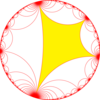
|

|

|

| |||||||
| Coxeter | |||||||||||
| Orbifold | *∞∞∞∞ | *2 | ∞∞∞∞ | 2 | |||||||
See also
References
- John H. Conway, Heidi Burgiel, Chaim Goodman-Strauss, The Symmetries of Things 2008, ISBN 978-1-56881-220-5 (Chapter 19, The Hyperbolic Archimedean Tessellations)
- "Chapter 10: Regular honeycombs in hyperbolic space". The Beauty of Geometry: Twelve Essays. Dover Publications. 1999. ISBN 0-486-40919-8. LCCN 99035678.
External links
- Weisstein, Eric W. "Hyperbolic tiling". MathWorld.
- Weisstein, Eric W. "Poincaré hyperbolic disk". MathWorld.
- Hyperbolic and Spherical Tiling Gallery
| Tessellation | |||||||||||||
|---|---|---|---|---|---|---|---|---|---|---|---|---|---|
|   | ||||||||||||
| |||||||||||||
| |||||||||||||
| |||||||||||||
